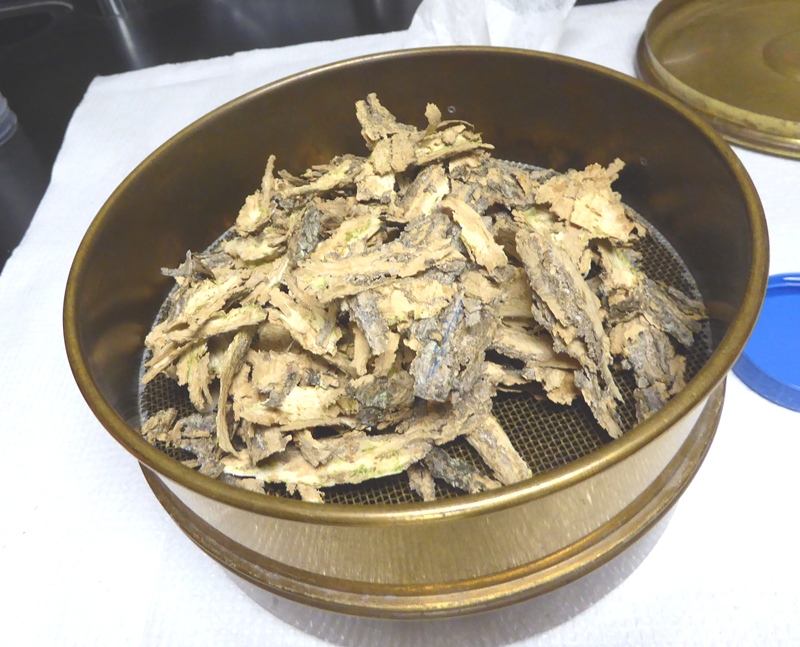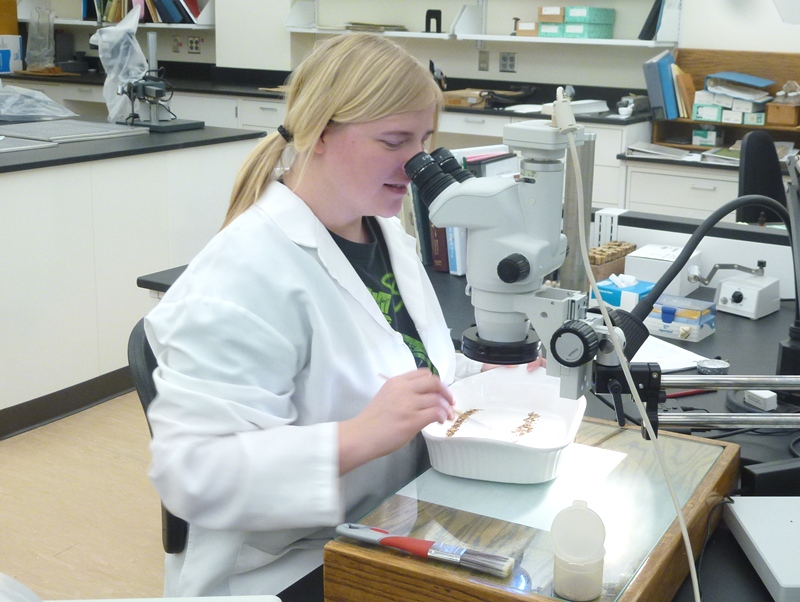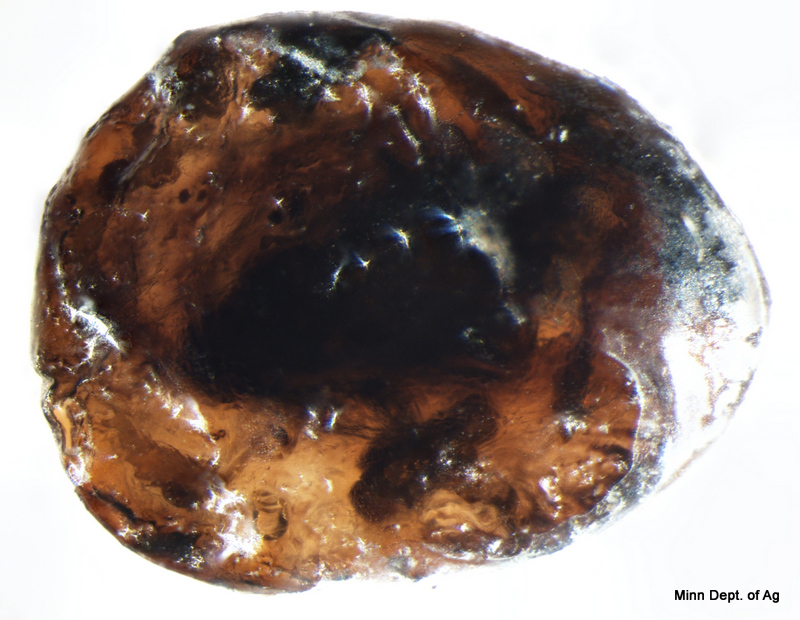This method was devised by Dr. Leah Bauer with the USDA Forest Service Northern Research Station in Lansing, MI. A 10 x 50cm section of outer bark is scraped off the trunk of an infested ash tree using a drawknife. The bark is collected by a plastic sheet laid at the base of the tree and then transferred to a paper bag to dry out and avoid the growth of mold while in storage. After the bark has dried for a month, the sample is placed into a sieve and shook for two minutes. Once done sieving the sample, the fine debris is transferred to a ceramic dish and analyzed underneath a dissecting microscope for the presence of parasitized EAB eggs.
This method was devised by Dr. Leah Bauer with the USDA Forest Service Northern Research Station in Lansing, MI. A 10 x 50cm section of outer bark is scraped off the trunk of an infested ash tree using a drawknife. The bark is collected by a plastic sheet laid at the base of the tree and then transferred to a paper bag to dry out and avoid the growth of mold while in storage. After the bark has dried for a month, the sample is placed into a sieve and shook for two minutes. Once done sieving the sample, the fine debris is transferred to a ceramic dish and analyzed underneath a dissecting microscope for the presence of parasitized EAB eggs.
A method used to collect adult parasitoids by use of pan traps. Yellow bowls are affixed to the trunks of ash trees with shelving brackets and filled with a clear propylene glycol solution. This liquid traps insects that are attracted to the yellow color of the bowl. Traps are sampled weekly throughout the summer. Samples are poured through a filter, frozen and screened for parasitoids in the late fall.

A method used to collect adult parasitoids by use of pan traps. Yellow bowls are affixed to the trunks of ash trees with shelving brackets and filled with a clear propylene glycol solution. This liquid traps insects that are attracted to the yellow color of the bowl. Traps are sampled weekly throughout the summer. Samples are poured through a filter, frozen and screened for parasitoids in the late fall.

A method used to collect adult parasitoids by use of pan traps. Yellow bowls are affixed to the trunks of ash trees with shelving brackets and filled with a clear propylene glycol solution. This liquid traps insects that are attracted to the yellow color of the bowl. Traps are sampled weekly throughout the summer. Samples are poured through a filter, frozen and screened for parasitoids in the late fall.

Biosecurity will be the most effective method to protect your animals. Minimize access of wild birds to cattle and their environment.
- Manage the movement of cattle and their transport as much as possible.
- Do not feed unpasteurized colostrum or milk to calves, cattle, or other mammals.
- Implement precautions for caretakers and veterinary teams handling sick cows, sick or dead birds, small mammals, and unpasteurized milk.
- Separate (quarantine) all new or returning animals for at least 21 days.
- Contact your herd veterinarian if increased cow illness is observed in your herd, specifically in second lactation or greater cows that are 150 days or more in milk.
Biosecurity will be the most effective method to protect your animals. Minimize access of wild birds to cattle and their environment.
- Manage the movement of cattle and their transport as much as possible.
- Do not feed unpasteurized colostrum or milk to calves, cattle, or other mammals.
- Implement precautions for caretakers and veterinary teams handling sick cows, sick or dead birds, small mammals, and unpasteurized milk.
- Separate (quarantine) all new or returning animals for at least 21 days.
- Contact your herd veterinarian if increased cow illness is observed in your herd, specifically in second lactation or greater cows that are 150 days or more in milk.
Biosecurity will be the most effective method to protect your animals. Minimize access of wild birds to cattle and their environment.
- Manage the movement of cattle and their transport as much as possible.
- Do not feed unpasteurized colostrum or milk to calves, cattle, or other mammals.
- Implement precautions for caretakers and veterinary teams handling sick cows, sick or dead birds, small mammals, and unpasteurized milk.
- Separate (quarantine) all new or returning animals for at least 21 days.
- Contact your herd veterinarian if increased cow illness is observed in your herd, specifically in second lactation or greater cows that are 150 days or more in milk.
Wild birds, wild animals, poultry, dairy cattle, and newborn goats have tested positive for H5N1 in Minnesota.
Infections in cattle have been traced back to infected wild birds. Research is continuing on the transmission route between animals. The newborn goat kids that were diagnosed in Minnesota shared a water source with infected poultry that had been depopulated at the same site.
Sick cattle are typically isolated and recover. Depopulation of cattle is not recommended. Milk from sick cows is diverted from the food supply. Pasteurized milk is safe to drink.
Federal funding is possible for pre-movement testing of lactating cattle through the information below:
Minnesota Department of Agriculture communicates and works closely with the University of Minnesota, Minnesota Department of Health, Minnesota Board of Animal Health, United States Department of Agriculture, Veterinary Diagnostic Laboratory, and industry partners to share information and develop plans to be best prepared.
Wear clean boots or boot covers, clean clothing, wearing disposable gloves, and safety goggles. For additional guidance see the Centers for Disease Control and the Minnesota Department of Health.
- Poultry questions should be directed to the Minnesota Avian Influenza hotline 1-833-454-0156.
- The Department of Natural Resources is addressing sick and dead wild bird reports, contact local DNR wildlife staff or the DNR information center at 888-646-6367.
- Any other diseases contact the Minnesota Board of Animal Health: 651-296-2942 or your district veterinarian (business hours).
- Human health questions can be directed to the Minnesota Department of Health: call 651-201-5414.
- Milk and food safety concerns can be directed to the Minnesota Department of Agriculture at 651-201-6300.
- Biosecurity Assessments and deterrent options are available through the USDA APHIS wildlife services: Jason Gilsdorf or any wildlife services personnel for assistance at 612-271-5119 or Jason.M.Gilsdorf@usda.gov
According to the CDC, human infections with avian influenza A viruses can happen when enough virus gets into a person's eyes, nose, or mouth or is inhaled. Raw milk from infected cattle can carry the virus and make people sick. People should not prepare or eat uncooked or undercooked foods, such as unpasteurized (raw) milk, or raw milk products, from animals with suspected or confirmed Avian Influenza A (H5N1) infection.
Wild birds, wild animals, poultry, dairy cattle, and newborn goats have tested positive for H5N1 in Minnesota.
Wild birds, wild animals, poultry, dairy cattle, and newborn goats have tested positive for H5N1 in Minnesota.




